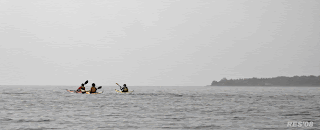F.A.K.E.
We have often discussed how many kayaks are enough and why. Most of us are not presently paddling the first kayak we ever purchased and it is likely we no longer own that boat. More over, it is likely that we have owned several different boats at different times and presently own more than one. Now, why is that?
Sometimes, because there is only a limited opportunity to test paddle kayaks, we find that that perfect new boat doesn't work in certain conditions as well as we had hoped. More often, and usually right after taking delivery of our new (or used) kayak, we cast our eyes on some new offering that has lines that speak to us in a way a great work of art speaks to an artist. End game: we want that boat...too.
Right now, how many boats do you own? How many boats do you own that you hardly ever (if ever) paddle but cannot let go of because it is a classic (e.g. my Romany)? How many boats do you have that you know you will not use and which would serve you better being sold to put cash in your pocket? I don't need answers to these questions, but I pose them to make us all aware of our sickness. Yes, our sickness. We, my fellow paddlers and lovers-of-kayaks are addicted to boats.

For some of us it is the sensuousness of the curves, or the mimicking of traditional Greenland lines or colors or materials or...or just kayaks in general. Face it, we need help, but a search of the medical literature shows that we are an ignored, disadvantaged minority in this country. Never, in a search of the Congressional Record, has a senator or representative risen to the floor to proclaim the pain and need of the kayak addict (KA). Never has the AMA or any other medical group or college offered training on the treatment for the KA. My dear friends and colleagues, there is no treatment. I am an MD and have discussed this with my colleagues in psychiatry; and I can tell you: that they have little interest in our plight. Knowing all this and realizing that we will not likely see a cure in our life time, we need to address the main secondary need of the KA patient: money.
Unless the country wants to see crime rates rise as we, like all addicts, pursue the quest for the money we need to satisfy our addiction, our government must pass the F.A.K.E act which I hereby propose:
The Federal Assistance act for Kayak Enthusiasts is a simple act asking that recognized addicted kayakers (come on, ACA, you need to find a way to credential us) be given a yearly stipend that would have to be applied to the purchase of a new or used kayak. Passing this is critical to our interests, the needs of kayakers and the needs of our country. Upon its enactment:
1. Crime rates would plunge as we would have the cash we need.
2. The economy would surge as money flowed from kayaker to kayaker to kayak dealer.
3. As a result, employment would rise dramatically.
It isn't going to be easy, so the sooner we get started on this the sooner it will happen. We need a steering committee to organize our campaign for the rights we deserve. We need to write letters, take out TV ads, contact our people in government, organize demonstrations (peaceful) and just get the word out. We are people of action and we take risks. WE CAN DO THIS.
And, once we have celebrated the passage and enactment of F.A.K.E. we can start working on the B.O.O.B., act: Booty Only Offered to buy Blades.
Clearly,we have our work cut out for us
Paddle safe...
DS























